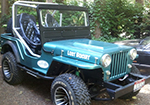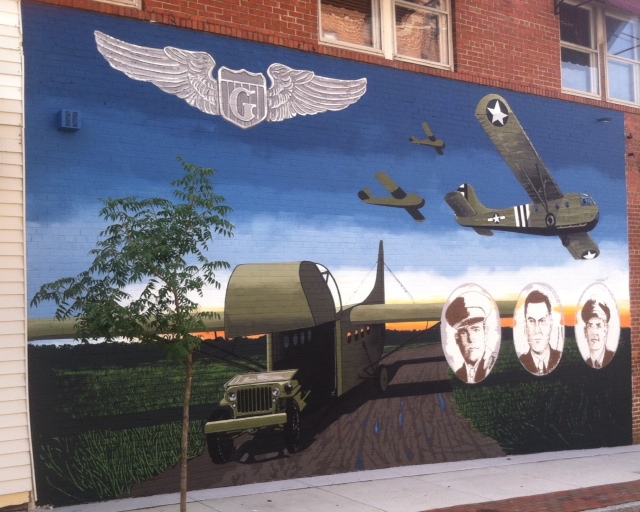UPDATE: Charles noted that these three me were pilots, not paratroopers.
Jim alerted me to this mural in Sanford, North Carolina. The city of Sanford has been adding murals to downtown that preserve local history. One in particular is a glider with a jeep emerging from it that honors three of the town’s glider pilots, according to this article.


The WACO CG-4A glider pictured was used by the US Army Air Force, the US Navy, the RAF and the RCAF. 13,900 were built.
The three men being honored on the Sanford, NC CG-4A glider mural were USAAF, Troop Carrier glider pilots. They flew the gliders and were NOT paratroopers, nor were they to become infantry troops after landing. Their orders were to gather at a specified location so they could be returned to their base ASAP for another flying mission if necessary.
FWIW, the Navy putzed around with gliders but did use them.
Charles Day
National Secretary,
National WWII Glider Pilots Association, Inc.
Thanks for that correction Charles. That was my mistake.
On another note, an Army old motor pool worker whose father and brother also worked in the Army’s motor pool in and after World War II told me that the Army once tested a glider-jeep. As I understand it, wings were installed on a jeep so that is could fly. Once it landed, charges were fired to blow off the wing components so the jeep could drive away. Glider-jeeps were intended to be used as part of D-Day.
Successful tests were completed in the Southwest, but a test (or several?) in Britain were unsuccessful due to the more humid environment. Have you ever run across any information that corroborates such a story? Given the Army also tested a Helicopter jeep ( http://www.ewillys.com/2009/04/27/rotabuggy-or-blitz-buggy-the-flying-jeep/ ) it isn’t a far fetched idea that they at least considered a glider jeep.
Thanks,
– Dave
Dave,
I have never read or heard of an actual winged Jeep, in test, or otherwise. Sounds to me like a motor pool story. General Arnold expressed a very, very, similar WISH for a Jeep with wings that could be towed behind enemy lines, land, shed its wings and drive off into combat. This wish resulted in the second XCG-4 which was widened a bit to accommodate the Jeep, becoming the production CG-4A.
The Roto-Buggy was a purely British idea which I believe they flew only once and it was not cut loose to land on its own. I don’t believe the USAAF ever messed with the Roto Buggy. The Museum of Army Flying has the original ink drawings of the Roto Buggy (or at least they did in 2006 when I visited there). The USAAF did mess a bit with the British Roto Chute but i believe that was after WWII, prior to the advent of larger helicopters.
Did you ever hear the reason the moisture in Britain affected the Jeep with wings idea? In view of the glue/wood/plywood construction of the Horsa, Hamilcar and the unbelievably successful Mosquito I don’t see the effect of humidity?
Charles Day
National Secretary,
National WWII Glider Pilots Association, Inc.
Charles,
It’s possible the story wasn’t accurate, which is why I’m trying to verify it :-). He told me that it was the humid, wetter environment that kept the glider from flying well and I took it at face value, because I know very little about the aerodynamic effects (or the lack thereof) of humidity on flight. The gentlemen has since died. Whether his story was accurate or not, he sure was a crack mechanic with old jeeps!
I read that the rotobuggy vibrated so terribly the experiment was quickly cancelled. I don’t know why I thought the Army had run the test. That was just sloppy of me.
I appreciate your insights!
– Dave
Dave,
During WWII the USAAF had one test field with two sub fields for flight testing and from which to conduct flight experiments. That was Wright Field–not Wright-Patterson which did not exist as a combined field until the USAF. The sub fields were Clinton County Army Air Field (CCAAF), glider test and experiment and Muroc (renamed Edwards after Glen Edwards was killed flying the wing). CCAAF came into existence as the glider field in order to get gliders off Wright Field and away from all the activity there with powered aircraft. Being the roto-buggy was more of a glider than powered I am sure that a USAAF experimental Jeep with Wings would have info and paperwork tied directly to CCAAF and Wright Field. I have never seen or heard of it. In 1941-42 when the AAF began glider designs and procurement we were two years or more behind the Brits, Germans, Russians, Poles, and any other country. Based on known (and shared) British designs already in progress the US developed design requirements which were sent to eleven companies. Only four responded. WACO was the only one to deliver designs that met requirements and passed stress tests. It was during this design time that Gen Arnold expressed his desire for the flying Jeep thus influencing the nose opening design of the XCG-4 that continued design in the CG-13A and CG-15A. There were several “wanna be” glider designs (that crawled out of the woodwork) presented to the USAAF by companies in the CA desert area which did not meet AAF criteria and were turned down. All of them were conventional glider designs and had nothing to do with the Jeep. The motor pool flying Jeep story is so word for word for General Arnold’s wish for a flying Jeep that I believe the story is a post war adaptation of the General’s wish. I also am thinking, this motor pool flying Jeep would have been done in 1941 or well before June 1942 when the Jeep carrying CG-4A was accepted. In 1941 would the Army have given up one of its new Jeep 1/4 T trucks to a rogue company for a rogue idea of adding wings and making the Jeep fly?
Charles Day
National Secretary,
National WWII Glider Pilots Association, Inc.
Charles,
Those are all good points. Your timeline of events is especially convincing. In addition, the first standardized jeep wasn’t produced until late October of 1941, so that narrows the timeline even more. Again, I appreciate those insights!
– Dave